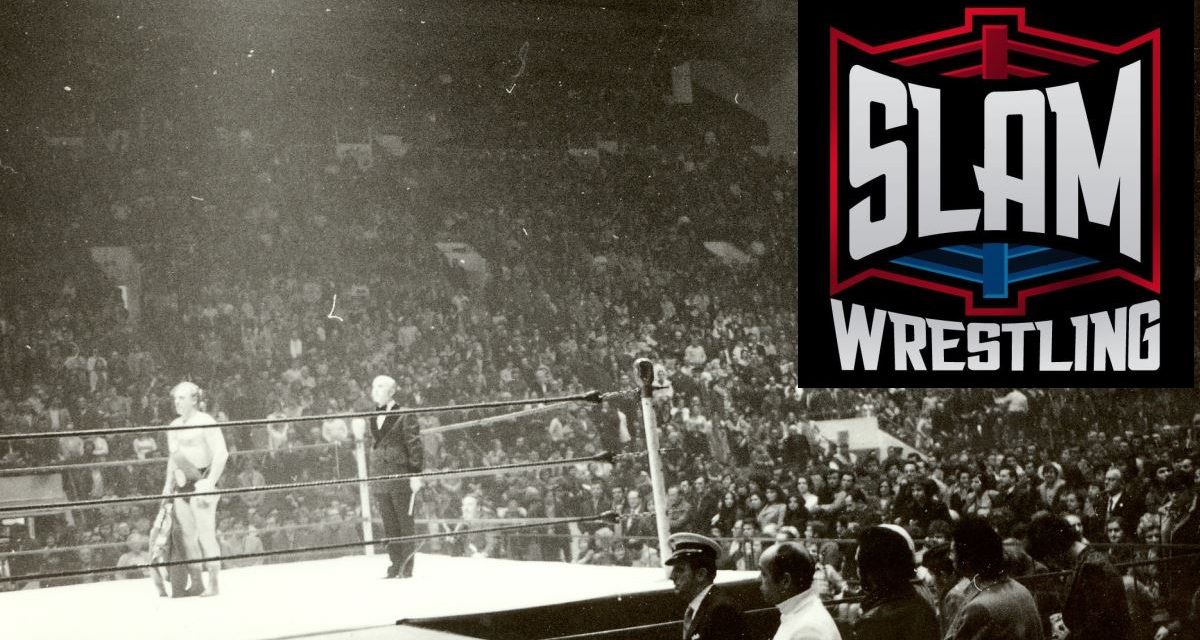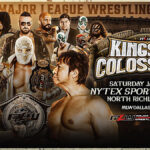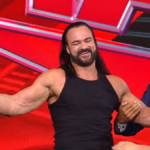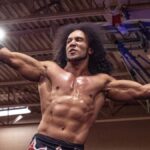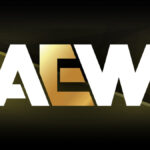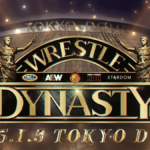Talking with Jerry and Bobby Christy is a little like going into a time machine. Given that their uncles were 1930s wrestlers Ted and Vic Christy, and that their own wrestling careers ended in 1978, that’s natural.
But it’s far more than that. The Christy brothers represent something long gone. No, not the fact that they were actual brothers billed as brothers (and there were disbelievers). It’s more the whole love of the business, the rub from celebrities from two life-long Californians, and the simple pleasure of telling gossip.
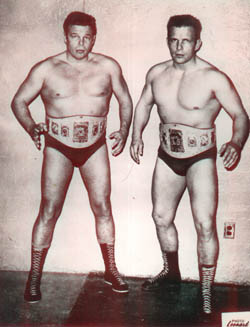
Jerry and Bobby Christy. Photo by Bob Leonard
Even today, their enthusiasm is infectious, and it is easy to find oneself swapping stories with them for many hours. Some of the stories are even printable, without risk of lawsuit, damaged reputation or broken marriage.
“I have days and weeks to talk about wrestling. I live in the past,” admitted Jerry Christy, older by eight years than his brother Bobby. “I would have to say that I probably know more about wrestling than anybody alive. I say that seriously. I, as a child, sat on the lap of somebody who was as famous a Hulk Hogan in those days — Man Mountain Dean.”
Bobby can remember going to see his uncles wrestle as well, recalling especially the all-wooden frame stands. “I would be holding on to the post watching my uncle or uncles in the ring,” he said. “I was just so engrossed in the matches, even at a very early age, that I was oblivious to all the people around me.”
In all, there would be four Christys in the ring, the name shortened from Christensen by Los Angeles promoter Lou Daro. Ted, born in 1910, and Vic, born in 1912, would begin in 1931. Their older brother, Walter — born in 1908 — had two pro wrestling matches after dabbling in boxing. Walter would have two sons, Jerry and Bobby, who would both follow their uncles into pro wrestling.
“When it all started, Vic was 6-3, and he was skinny. So somebody told him that if he just took up wrestling, he’d gain weight. There used to be a wrestler named Doc Mulligan that had a school. Vic went to Doc Mulligan’s school. Doc Mulligan said that he was the most unlikely guy to ever become a wrestler, but Vic became a wrestler and he was world champion twice,” said Jerry. Early on, Vic worked the carnival circuit, with a fellow named Shorty Costello. “Shorty Costello would take anybody on in boxing, and Vic would take anybody on in wrestling,” explained Jerry.
Both Vic and Ted Christy became major stars in the days before television. “Gorgeous George and Danny McShain copied Ted’s strut,” said Jerry. “Ted used to walk to the ring, and before the match started, everybody hated him, just the way he walked to the ring and the way he acted.”
The nephews found out how big their uncle Ted was internationally when they went to New Zealand at the end of the 1960s. “Our uncle Ted had wrestled there in 1940. We were there about 1969. The people, the wrestling fans there, they were really connected with it, and they would be telling about matches — they even told us of seeing our uncle — and these are people who are still attending, for the last 20 or 30 years,” recalled Bobby.
But for all the accomplishments in the ring of the younger Christys — International tag team champions, three trips to Japan under different guises (The Christys, the Peace Brothers, the Vigilantes), and a couple of other titles — they pale in comparison to the sheer fun the brothers seemed to have along the way.
The senior brother, Jerry knew from the age of six that he wanted to be a professional wrestler like his uncles. Vic and Ted were his primary trainers, and Jerry also makes mention of the help he got from Tony Morelli, Jim LaRock, and a book that Red Berry put out in the 1940s. Jerry would debut 1951 in San Bernadino. From 1951-53, Jerry would wrestle six nights a week, often on television, and was on the cover of a TV Guide. “I had my 15 minutes of fame in those days. Everybody knew me,” he bragged.
At the time, the Wrestling Workouts were on television in Hollywood, and Vic and his nephew Jerry once worked out on the show. “My grandmother and my whole family were watching. Jerry and Vic both had the same body type,” explained Bobby. “They moved alike in the ring, and we would be sitting there watching, and we would be arguing which one was Vic and which one was Jerry. There was just a resemblance; it would be hard for us to tell.”
Some promoters would book Vic and Jerry as brothers, others as uncle and nephew. “Vic and I wrestled as brothers, and we were never questioned, whereas Bobby and I were questioned all the time, and we are brothers!” laughed Jerry.
Despite his early success and fame, Jerry was drafted and chose the U.S. Navy, which he served with from 1953-55. “In boot camp, I choked a guy out, a bully, with the blessings of everybody,” claimed Jerry. Upon his return, the California scene had changed. “I came out of the Navy, and they didn’t use me here, so I had to go to Hawaii, and then to Texas,” said Jerry. In Texas, Jerry was known as Kid Robin. Before his brother was to enter the sport, Jerry was Louisiana Heavyweight wrestling champion in 1958, and Mississippi tag team champion with Jack Curtis that same year.
Bobby’s wrestling career had to wait until 1958. “Periodically in Jerry’s publicity, they’d mention that he had a brother that wrestled at UCLA,” said Bobby, who was intramural wrestling champ at UCLA in 1958. “I had the opportunity to get into professional wrestling. Jerry was wrestling in Florida for Cowboy Luttrall at the time. So Jerry got me booked into Florida.”
His first match was in Winterhaven, with Jerry as his partner, against Simon Senatas and Edouardo Perez. “The first match I can’t forget, because I was standing over there in the corner, as Jerry starts out, and I say to myself, ‘Please, don’t get too close. Don’t tag! I don’t want to go in there in front of all those people.’ I was terrified.”
Getting comfortable took a while, said Bobby. “It was about a year before I got the butterflies out of my stomach. It was always nervewracking. It was always hard when you’d go from one territory to another. You were unknown to them. When you would go into the ring, you’d look to the back, and you’d have a lot of the wrestlers, the promotion and everything who is going to decide how you’re going to do by maybe just that first match. You’re hoping that you’ll have a good match.”
The Christys would develop into respected workers, if not headliners. Bobby is quite willing to admit that his big brother was his guide in those early years, as he learned the steps in Florida, then the Carolinas. Their quick tag moves would lead to their finisher, the sleeper hold.
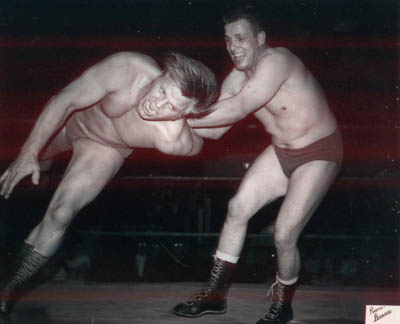
Bobby Christy twists Gil Hayes in Stampede Wrestling. – photo by Bob Leonard
One particular place they succeeded was in the Stampede Wrestling promotion.
“Both were good hands — solid face workers, sold really well, and had a pretty good amount of fire. Stu thought well of them,” recalled Stampede promoter Bob Leonard. “They worked most often in tags, but did some good singles stuff too.” They’d hold the International tag belts in Calgary one time each year, in 1964, then 1967-69, and twice in 1970, feuding with the likes of the Steigers, Sweet Daddy Siki and Duke Noble, The Beast (Yvon Cormier) and Bob Sweetan, Bill Dromo and Gil Hayes, and Bob Sweetan and Gil Hayes. As singles workers, Jerry had a good run with Abdullah the Butcher, and held the North American title in 1970.
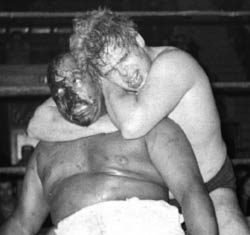
Bobby Christy has the sleeper hold on Abdullah the Butcher in Stampede Wrestling. – photo by Bob Leonard
One of the youngsters they influenced was “Cowboy” Dan Kroffat. “In 1969, when I started, those guys were the two babyfaces in Calgary. But they were a lot older than me then. I remember I was 23, 24, and I think they were 36, 39, maybe at the time,” said Kroffat. “They were California boys. But what made them really unique was that they were very personable, both of them. They treated rookies well, and welcomed rookies. They really were very friendly to me, and I rode with them. I must have put thousands of miles on with those guys, hour after hour, in their car with them traveling across the Prairies. Not great workers by any stretch, but they knew how to work the crowd.”
Like any wrestler who ventured to Alberta, the Christys have Hart stories.
Bobby: “Jerry had this sleeper on this young guy, this very young guy”
Jerry: “I was about to put him out.”
Bobby: “Whoever was refereeing informed them that he had Smith Hart in a hold, so they whispered to him what to do rather than put him out for real.”
Jerry: “That would have been embarrassing. They probably assumed that we knew who he was.”
Another story is meeting one of Canada’s most important politicians of the 1960s, John Diefenbaker, in Saskatoon. “What a nice guy he was,” said Jerry. Actually, it was the massive Jess Ortega that introduced them to Dief. “Can you imagine this huge guy, went up, put his arm around his shoulders. Then he called us over. We talked, in fact, we broke off the conversation, Diefenbaker was so friendly, asking us all about wrestling.”
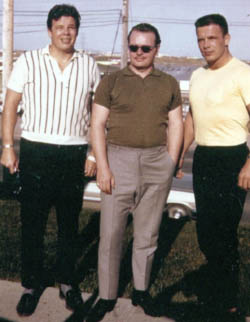
Jerry Christy, Bob Leonard, and Bobby Christy. – photo courtesy Bob Leonard
The inverse to Calgary, said Bobby, was Texas, where none of the Christy boys had ever done well. “I was the last to go there, and I anticipated not doing well,” Bobby said, referring to a trip to Houston. Despite the packed building, Bobby said he only got $15 from promoter Paul Boesch, who was Morris Sigel’s partner in the town. Boesch heard Bobby complaining and Bobby was gone four days later.
Talk of Houston, however, brings up a “What If?” from Jerry: “We could have had that territory.” On the same winter night in 1966 that Bobby and Boesch agreed on him leaving the territory, Bobby took Morris Sigel’s daughter Shirley out on a date. “We were together from that point on,” Bobby explained. “One of the things that she asked me, she says, ‘What the hell is the matter with you? You never go up to the office.’ Apparently that was a territory that they wanted the wrestlers to all come to the office — when you come to a territory, of course you’ve got to go to the office — but I’d open the door, and I’m hitting bodies. All the wrestlers, they were just hanging out in the office. I don’t know why that was or why they were doing that like a social thing. I never have, I never was a kiss ass. I never went to the office. I was going to make it on my own merit. Then I told her. She said, ‘They thought you were too conceited or something to go up to the office.’ I said, ‘I don’t go up to the office.’ Anyway, we were together. Her dad was not in good health at the time. After this whirlwind romance, she was wanting to be together, probably to get married. She said that she knows when her dad passes away that Paul Boesch would get her right out of there, edge her out. If it would have been up to me, had that been my desire, I could have been with her and we probably could have had the Houston territory.”
Paul Diamond (Paul Lehman), who had his own run-ins with promoters over the years, agreed that the Christys weren’t ones to hang around the office. “We never kissed ass. If you didn’t kiss ass in a territory, you didn’t get over.”
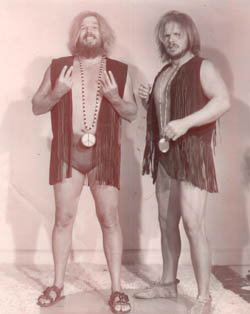
The Peace Brothers, Brother Jerome and Brother Joseph
Aside from under their real (shortened) names, the Christys worked as the Peace Brothers, Brother Jerome and Brother Joseph, from Big Sur, California (which they claim that Pedro Martinez in Buffalo ripped off for the Love Brothers), and the Vigilantes.
Jack-of-all-trades for the Los Angeles office, Art Williams, laid claim to naming the Vigilantes, around 1956. “Great guys. I worked with Mike LeBell, and he said, ‘Try to come up with a name.’ So I gave them the name the Vigilantes. The office tried to get them over. To some success, they got over, but they just didn’t have the magic. They weren’t bad, they were a good team, but they weren’t great,” said Williams.
The Christys would make three trips to wrestle in Japan, 1966, 1972 and 1977.
“In Japan, you’re very closely knit because you’re staying in a hotel and traveling,” Bobby recalled of the 1972 trip. “There was Nelson Royal, the Hamilton brothers, Danny Hodge, Fritz von Goering, Waldo von Erich. I didn’t want to see it end. Being around those people, it was the nicest group of guys I’ve ever been around in wrestling.”
Bobby continued reminiscing about their past. “It was a good life, because Jerry and I were tourists at heart. We were paid to be there. We took full advantage. Every tour that we took into Japan, we would be up bright and early in the morning and out to see as much of it as we could. We took advantage of all these other countries we were able to go to as a result of it — into New Zealand, Taiwain, Hong Kong, and all these places. We really enjoyed it. I enjoyed the travel that was connected with it,” he said, continuing.
“There were wrestlers that would go over to Japan, we would be out and we would come back; you’d see them in the lobby when we’d go out, we’d see them in the lobby when we came back. Especially that first tour over there — we weren’t wrestling every night and there was a lot of time off. Jerry and I went to see everything. The only other wrestler that we knew that did the same thing as us was Paul Diamond. He went to see everything.”
It seems they have a story on everybody.
One from Jerry: “I spent time in Hawaii. It was a good crew over there with Nicky Bockwinkel, Lord Blears, the one we were together all the time with was Enrique Torres and Kata, Fuji Fujiwara. Ed Francis, of course, was promoting. When I was there, I used to see Al Karasick, who at that time was no longer promoting. You’d walk out into the office, and you’d see in a little cage. He loved gambling and card playing. I would say that was another enjoyable highlight of wrestling.”
One from Bobby, who is working in Texas as a referee and Paul De Gaulle was competing: “I can’t remember who he was with, but Paul could not walk out of a wet paper bag. Paul was helpless. He was in the ring and the other wrestler was equally as helpless, and they had a shoot match. … Two people in there, both pulling each other’s hair, and neither knows what to do. I didn’t know what to do. I tried to get them apart. It was just something I didn’t forget. The concept of wrestling, and the real ability to wrestle, it had become a lost artform by the time we got out of wrestling. We watched the transition of the really good workers, the really good wrestlers, to what came later.”
But Jerry always has another story … then another …
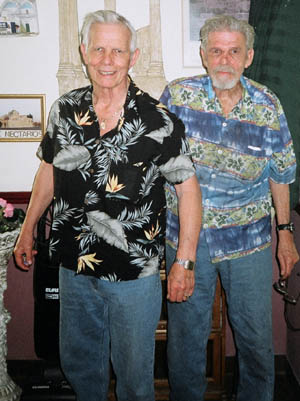
Bobby and Jerry Christy in June 2006. -photo by Greg Oliver
On Angelo Poffo: “When I was wrestling at the Amphitheater, I was wrestling Angelo Poffo, and he heard I played chess. So we went down somewhere deep in the bowels of the Amphitheater, because we were wrestling on TV. I’m nervous, big crowd, just got into town and everything. He beat me. Now he wants to play me again. I beat him the next 10 games.”
On mistaken identities: “I was in Puerto Rico, and I asked Carlos Colon who was there. He said Nikolai Volkoff. ‘Nikolai Volkoff! Oh boy, I’ve got to see him!’ He gave me his address, and I went out there. This monster opens the door, it was another Nikolai Volkoff. We became friends too. But Nikolai Volkoff was one of my favorite people. Steve Gob, he was in love with Rose Roman, but Rose Roman wouldn’t marry poor old Steve.”
In the end, the fun came to a stop because of the death of their father in 1977. “My mother was just totally a stay-at-home mom. She didn’t even know how to write a cheque. I did not want to go out anymore,” said Bobby. The brothers did a final, contracted trip to Japan, and looked after their mother for seven years as she drifted into Alzheimer’s before her death in 1984.
Jerry’s last match was as a singles worker at the Scoffield Barracks in Hawaii against The Missing Link (Pampero Firpo), in 1978. After wrestling, he was a bouncer and did odd jobs around Los Angeles. Married three times, he has no children.
Bobby never married, but unlike his brother, did settle into a routine, driving a Coke truck for than 20 years, so he got a decent pension.
Today, living in the sprawl that is urban Los Angeles, Jerry and Bobby Christy are content to do what they want to do. If that includes telling stories of their wrestling past to an open-eared reporter, all the better.
The thank you email from Jerry for the extended lunch summed it up nicely: “Once again you brought back memories of some of Bobby and my halcyon days. I wish this was the Twilight Zone so I could go back there again.”
